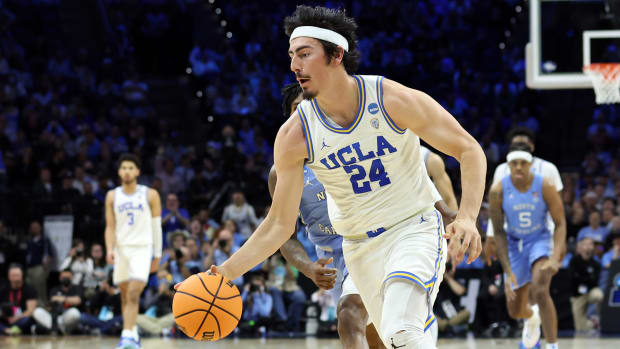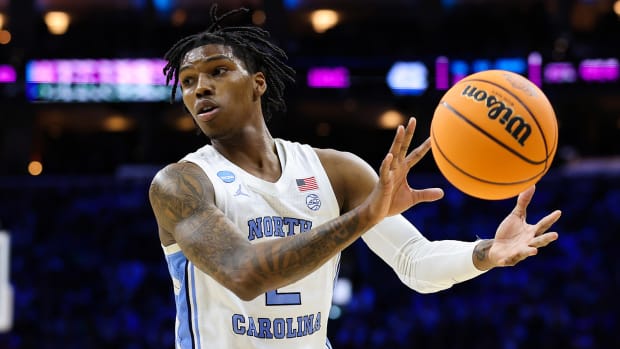View the original article to see embedded media.
The NBA’s early-entry deadline for the 2022 draft elapsed Sunday night, finalizing the pool of eligible players as the predraft process begins in earnest. As I see it, there were no massive surprises this year in terms of college prospects deciding to test or return to school, but per usual, some intriguing names opted to defer their draft decisions to next season.
A few players I’d originally earmarked as candidates for this column chose to test the waters—Iowa’s Kris Murray, Arizona’s Dalen Terry, and Toledo’s Ryan Rollins to name a few—which technically leaves the door open for an NBA exit, thus making them and others ineligible for this particular column. Depending on who stays and who goes, we may circle back on more returners after the NCAA’s June 1 withdrawal deadline. For now, here are five prospects to prioritize on early watch lists for the 2023 draft.
Tyrese Hunter, PG, transfer portal
Height: 6' 0" | Weight: 180 | Rising sophomore
Last week, Hunter became the most wanted man in the transfer portal after announcing his plans to leave Iowa State. He flew relatively under the radar in high school for a four-star prospect and never had a full national recruitment until now, with heavy hitters already lining up offers. Hunter won Big 12 freshman of the year, then broke out in the NCAA tournament and led the Cyclones to the Sweet 16, putting himself on the map nationally and in the minds of NBA teams going into his sophomore year. In my mind he projects as the top returning guard prospect at this point in time. Hunter doesn’t turn 19 until August, and another year of development in college should ultimately help him quite a bit and solidify him as a legit first-rounder.
Hunter potentially has quite a bit to offer as a prospect, and to me the discussion begins with his exceptional mental makeup, particularly for a teenager. He leads and makes decisions with the type of poise that older teammates follow, he doesn’t take plays off, and he defends with tenacity. He’s also exceptionally fast, which helps cover for what he gives up in terms of size (he’s listed at 6' 0”). While still learning to distribute in the halfcourt, Hunter is an unselfish passer, takes great care of the ball, and doesn’t get sped up easily. His floor seems pretty secure right now as a high-quality NBA backup, with the potential to be much more than that. Teams will want to see him improve his three-point shooting next season (his 27.4% from long range will likely tick up, but it’s a matter of how much).
Hunter will also need to work on his finishing and get to the line more often: learning to play against size was a challenge for him this season, and small point guards have to be exceptionally efficient to carve out roles in the NBA. But considering his work ethic and extremely strong intangibles, there’s a pretty good chance he breaks out in full no matter where he plays next season.

Bill Streicher/USA TODAY Sports
Jaime Jaquez, F, UCLA
Height: 6' 7" | Weight: 225 | Rising senior
Last week, Jaquez announced he’d return for his senior year, a decision that surprised some around the NBA: I had him projected as a late first-rounder, and there was a pretty strong chance he would have been drafted in the top 40. Jaquez has already convinced a tangible segment of the NBA that he has strong role-player chops for the next level, but he played hurt for the majority of his junior season, and his three-point percentage dipped from 39% as a sophomore to 27% (though his free throws trended up). Jaquez isn’t going to improve much physically, and nobody questions his makeup, so the key to solidifying first-round status will be improving his individual efficiency and shooting.
Jaquez has already earned the respect of many NBA decision-makers with his intangibles and approach to the game: he’s competitive, physical, guards whoever he has to go guard, and has a big enough frame to defend smaller fours and slower wings. He’s not a great run-jump athlete, but he’s coordinated, and taking the summer to get healthy and hopefully remain that way could certainly help him in that department. As long as Jaquez can improve his jumper, he projects as a viable bench piece in the pros who can help enhance lineups with his scoring, feel, and toughness. He won’t be a sexy draft pick by any means, but there’s an opportunity for him to improve his stock. A lot of people are already somewhat sold here.
Jordan Hawkins, UConn
Height: 6' 5" | Weight: 175 | Rising Sophomore
Although Hawkins’ playing time was sporadic this season, the glimpses he offered were pretty interesting: he’s an above-average athlete and explosive leaper, has length and a frame that can fill out, and has flashed a diverse offensive skill set that’s still expanding in all facets. He’s not enormous for a wing and needs to keep adding strength—he converted just 37% of his 58 two-point attempts this season and has to finish better—but he’s a capable three-point shooter, and there’s pretty palpable upside here. His dunks and flashes of skill pop on film.
Hawkins was a four-star recruit out of powerhouse DeMatha Catholic, so while he was somewhat under the radar entering college, there’s national pedigree here. UConn will turn over most of its backcourt minutes, leaving plenty of room for Hawkins to inherit responsibility. He will have to be more efficient, it’s unclear if he can make plays for teammates, and there’s polish needed here on all facets. But the presumable spike in volume coupled with his estimable talent as a scorer makes him a person of clear interest moving forward. Hawkins turned 20 shortly after his freshman year ended, so he’s older for his class, but this may just be a case where the lack of major minutes masked what was under the surface. Go back and watch his 16-point effort in 16 minutes against Auburn from November, and you’ll get the picture.
Arthur Kaluma, F, Creighton
Height: 6' 7" | Weight: 220 | Rising sophomore
Kaluma was a bit slow to come on as a freshman, but ended the year on a high note individually after returning from a knee injury (and playing with a large brace on his leg), and accomplished enough to pique real NBA interest moving into the fall. He put up a season-high 24 points and 12 rebounds against eventual national champion Kansas in the second round of the NCAA tournament, showcasing his explosive leaping ability and draining four threes. There’s certainly a lot of upside here on the surface: Kaluma has a broad upper body and extremely long arms, he’s powerful when he gets a full head of steam downhill, and he rebounds very well for his position. His tools and scoring ability will be worth a close look for scouts early next season.
There are a few cautionary elements here: Kaluma turned 20 in March, making him old for a freshman, and he’s a bit stiff physically, including his knees and feet. He doesn’t navigate tight spaces particularly well and may have to really improve his ball skills and jumper to be a difference-maker. He hasn’t shown creative acumen at this point in his career, and could be more consistent defensively. But considering his physical profile and the way he came on this season, continued improvement as a shooter and improved defensive effort with his disruptive length could earmark him as a first-round prospect pretty quickly. There’s always demand for athletic play-finishers with a range of secondary skills, and if this keeps trending in the right direction, Kaluma might be that.

Bill Streicher/USA TODAY Sports
Caleb Love, North Carolina
Height: 6' 4" | Weight: 195 | Rising junior
After spurring the Tar Heels on a surprising run to the national title game, Love announced Sunday that he’d be back for another go. It was likely the right decision: although the former five-star recruit somewhat revived his status as a prospect during the tourney, the fact remains that he struggled to score the ball efficiently over the course of the season and has much he can improve on with another year of college. Love shot just 38% on two-point attempts on high volume this season, which is almost a disqualifying number for a prospect, considering that finishing is one thing that never gets easier as players go up levels. But if he can get that number to a respectable place, Love is a good enough shooter that he should have something to offer teams as a scoring combo guard.
Love has always been a plus athlete and he’s good going to his strong hand, capable of beating guys downhill to spots. It’s become clear he’s not a true point guard—playmaking for teammates isn’t his forte—but he’ll likely need to be able to soak up some on-ball duties in the long haul at his size. North Carolina should again have him splitting duties with R.J. Davis, but Love needs to show signs of progress as a decision-maker, as he’s developed a reputation among scouts for being somewhat selfish. He has the tools to be a better defender, as well. If Love takes care of business, he could follow a similar path to Quentin Grimes, who also didn’t meet lofty expectations as a true freshman, but had a strong college career and wound up a first-round pick in the end. Love has the talent to do it if he makes the requisite tweaks to his style of play, but changing habits is often easier said than done.







